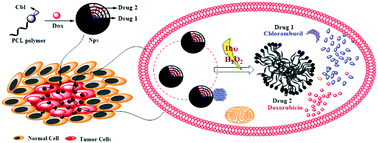Coumarin polycaprolactone polymeric nanoparticles: light and tumor microenvironment activated cocktail drug delivery†
Abstract
Highly sensitive hypoxia (H2O2)-activated photoresponsive polymeric nanoparticles for cocktail delivery of anticancer drugs doxorubicin (Dox) and chlorambucil (Cbl) were developed. The photoresponsive polymer conjugate was constructed by ring-opening polymerization (ROP) of caprolactone (as the tail) with 7-hydroxycoumarin chlorambucil (as the head). During nanoprecipitation, the polycaprolactone chain wrapped around the hydrophobic core (coumarin chlorambucil) to form a “shell”. Interestingly, the polycaprolactone-tagged coumarin-chlorambucil (PCL-CC) NPs provided sufficient space for co-encapsulation of another hydrophobic anticancer drug Dox with a loading efficiency of 13 wt%. The controlled release of Dox and Cbl from Dox–PCL-CC NPs was investigated under three different conditions: (i) in the presence of H2O2 (tumor microenvironment), (ii) photoirradiation using UV light of ≥365 nm for 60 min, and (iii) photoirradiation using UV light of ≥365 nm for 15 min in the presence of H2O2. Results showed that photoirradiation in the presence of H2O2 results in generation of reactive oxygen species (HOO–, OH–), which assist hydrolysis of the ester group in the polymeric backbone of Dox–PCL-CC NPs and UV irradiation leads to cleavage of the coumarin-chlorambucil ester linkage, leading to burst release of Dox and Cbl. The drug release profile from the NPs under three different conditions was monitored by different instrumental techniques, e.g. emission spectroscopy, MALDI-Tof mass spectrometry, DLS and HPLC analysis. In vitro biological studies revealed that the present system can efficiently deliver the cocktail anticancer drugs with full control over release into the tumor cells by means of H2O2 and light activation.



 Please wait while we load your content...
Please wait while we load your content...